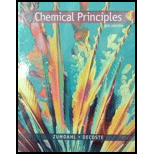
(a)
Interpretation:
The hybrid orbitals should be predicted which is used by sulfur atom(s) in
Concept Introduction:
When two atomic orbitals combine with each other to produce hybrid orbitals, redistribution of energy of orbitals of distinct atoms to form orbitals with equal energy occurs. This process is known as hybridization and the formed new orbitals are known as hybrid orbitals.
When the atomic orbitals overlap with each other in a region of high electron density, then molecular orbitals are formed. Overlapping of atomic orbitals determines the efficiency of interaction between atomic orbitals. Energy of bond molecular orbitals is less than the nonbonding molecular orbitals.
(a)
Explanation of Solution
On the basis of types of orbitals involved in mixing, different hybridization is classified as sp, sp2, sp3, sp3d, sp3d2, sp3d3.
sp-hybridization: It is formed when one s and one p orbital mix with each other in same shell of an tom to produce two new equal orbitals. This hybridization takes place in linear molecules.

sp2-hybridization: It is formed when one s and two p orbital mix with each other in same shell of an tom to produce three new equal orbitals. This hybridization takes place in molecules exhibits trigonal planar geometry.

sp3-hybridization: It is formed when one s and three p orbital mix with each other in same shell of an tom to produce four new equal orbitals. This hybridization takes place in molecules exhibits tetrahedral geometry. In this hybridization, no p-unhybridized orbital is present as all are hybridized and form four sigma bonds.
The given molecule is
Number of valence electrons in sulfur = 6
Number of valence electrons in oxygen = 6
Total number of valence electrons =
The bonds present between sulfur atom and oxygen atom is sigma and pi bonds and also one lone pair of electrons are present on sulfur atom which pushes the oxygen atom down. Thus, geometry of
Electronic configuration of sulfur is
Electronic configuration of oxygen is
The sulfur atom uses one
Lewis structure of

(b)
Interpretation:
The hybrid orbitals should be predicted which is used by sulfur atom(s) in
Concept Introduction:
When two atomic orbitals combine with each other to produce hybrid orbitals, redistribution of energy of orbitals of distinct atoms to form orbitals with equal energy occurs. This process is known as hybridization and the formed new orbitals are known as hybrid orbitals.
When the atomic orbitals overlap with each other in a region of high electron density, then molecular orbitals are formed. Overlapping of atomic orbitals determines the efficiency of interaction between atomic orbitals. Energy of bond molecular orbitals is less than the nonbonding molecular orbitals.
(b)
Explanation of Solution
On the basis of types of orbitals involved in mixing, different hybridization is classified as sp, sp2, sp3, sp3d, sp3d2, sp3d3.
sp-hybridization: It is formed when one s and one p orbital mix with each other in same shell of an tom to produce two new equal orbitals. This hybridization takes place in linear molecules.
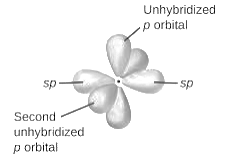
sp2-hybridization: It is formed when one s and two p orbital mix with each other in same shell of an tom to produce three new equal orbitals. This hybridization takes place in molecules exhibits trigonal planar geometry.

sp3-hybridization: It is formed when one s and three p orbital mix with each other in same shell of an tom to produce four new equal orbitals. This hybridization takes place in molecules exhibits tetrahedral geometry. In this hybridization, no p-unhybridized orbital is present as all are hybridized and form four sigma bonds.
The given molecule is
Number of valence electrons in sulfur = 6
Number of valence electrons in oxygen = 6
Total number of valence electrons =
The bonds present between sulfur atom and oxygen atom is sigma and pi bonds. There are three bond pairs of electrons surrounding the sulfur atom. The oxygen atom which forms double bond with sulfur atom has two lone pairs and remaining two oxygen atoms has three lone pair of electrons.
Thus, geometry of
Electronic configuration of sulfur is
Electronic configuration of oxygen is
The sulfur atom form double bond which each oxygen atom implies one s and two p orbitals are mix with each other to form sp2 hybridization.
Lewis structure of

(c)
Interpretation:
The hybrid orbitals should be predicted which is used by sulfur atom(s) in
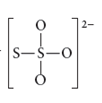
Concept Introduction:
When two atomic orbitals combine with each other to produce hybrid orbitals, redistribution of energy of orbitals of distinct atoms to form orbitals with equal energy occurs. This process is known as hybridization and the formed new orbitals are known as hybrid orbitals.
When the atomic orbitals overlap with each other in a region of high electron density, then molecular orbitals are formed. Overlapping of atomic orbitals determines the efficiency of interaction between atomic orbitals. Energy of bond molecular orbitals is less than the nonbonding molecular orbitals.
(c)
Explanation of Solution
On the basis of types of orbitals involved in mixing, different hybridization is classified as sp, sp2, sp3, sp3d, sp3d2, sp3d3.
sp-hybridization: It is formed when one s and one p orbital mix with each other in same shell of an tom to produce two new equal orbitals. This hybridization takes place in linear molecules.

sp2-hybridization: It is formed when one s and two p orbital mix with each other in same shell of an tom to produce three new equal orbitals. This hybridization takes place in molecules exhibits trigonal planar geometry.
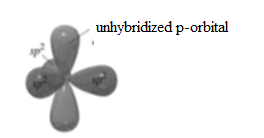
sp3-hybridization: It is formed when one s and three p orbital mix with each other in same shell of an tom to produce four new equal orbitals. This hybridization takes place in molecules exhibits tetrahedral geometry. In this hybridization, no p-unhybridized orbital is present as all are hybridized and form four sigma bonds.
The given molecule is
Number of valence electrons in sulfur = 6
Number of valence electrons in oxygen = 6
According to structure of
Total number of valence electrons =
The bonds present between sulfur atom and sulfur atom and one oxygen atom is pi bond and remaining two oxygen atoms are linked by sigma bond.
Thus, geometry of
Electronic configuration of sulfur is
Electronic configuration of oxygen is
The central sulfur atom uses one s-orbital and three p orbitals and thus hybridization of central sulfur atom is sp3
Lewis structure of

(d)
Interpretation:
The hybrid orbitals should be predicted which is used by sulfur atom(s) in

Concept Introduction:
When two atomic orbitals combine with each other to produce hybrid orbitals, redistribution of energy of orbitals of distinct atoms to form orbitals with equal energy occurs. This process is known as hybridization and the formed new orbitals are known as hybrid orbitals.
When the atomic orbitals overlap with each other in a region of high electron density, then molecular orbitals are formed. Overlapping of atomic orbitals determines the efficiency of interaction between atomic orbitals. Energy of bond molecular orbitals is less than the nonbonding molecular orbitals.
(d)
Explanation of Solution
On the basis of types of orbitals involved in mixing, different hybridization is classified as sp, sp2, sp3, sp3d, sp3d2, sp3d3.
sp-hybridization: It is formed when one s and one p orbital mix with each other in same shell of an tom to produce two new equal orbitals. This hybridization takes place in linear molecules.

sp2-hybridization: It is formed when one s and two p orbital mix with each other in same shell of an tom to produce three new equal orbitals. This hybridization takes place in molecules exhibits trigonal planar geometry.
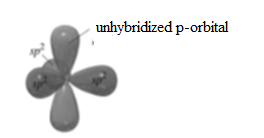
sp3-hybridization: It is formed when one s and three p orbital mix with each other in same shell of an tom to produce four new equal orbitals. This hybridization takes place in molecules exhibits tetrahedral geometry. In this hybridization, no p-unhybridized orbital is present as all are hybridized and form four sigma bonds.
The given molecule is
Number of valence electrons in sulfur = 6
Number of valence electrons in oxygen = 6
There are eight oxygen atoms and two sulfur atoms are present in the molecule and charge on the molecule is equal to -2.
Total number of valence electrons =
Here, each sulfur atom is linked with four oxygen atoms, two oxygen atoms are double bonded and two oxygen atoms are single bonded.
The two oxygen atoms present in the center of the structure are bonded by single bond. By bonding in this way, each atom completes its octet.
Thus, geometry of
Electronic configuration of sulfur is
Electronic configuration of oxygen is
Both sulfur atoms uses one s-orbital and three p orbitals and thus hybridization of both sulfur atoms is sp3
Lewis structure of
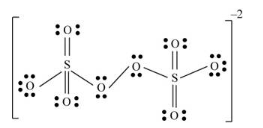
(e)
Interpretation:
The hybrid orbitals should be predicted which is used by sulfur atom(s) in
Concept Introduction:
When two atomic orbitals combine with each other to produce hybrid orbitals, redistribution of energy of orbitals of distinct atoms to form orbitals with equal energy occurs. This process is known as hybridization and the formed new orbitals are known as hybrid orbitals.
When the atomic orbitals overlap with each other in a region of high electron density, then molecular orbitals are formed. Overlapping of atomic orbitals determines the efficiency of interaction between atomic orbitals. Energy of bond molecular orbitals is less than the nonbonding molecular orbitals.
(e)
Explanation of Solution
On the basis of types of orbitals involved in mixing, different hybridization is classified as sp, sp2, sp3, sp3d, sp3d2, sp3d3.
sp-hybridization: It is formed when one s and one p orbital mix with each other in same shell of an tom to produce two new equal orbitals. This hybridization takes place in linear molecules.
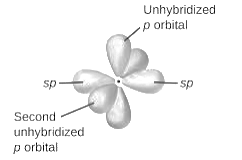
sp2-hybridization: It is formed when one s and two p orbital mix with each other in same shell of an tom to produce three new equal orbitals. This hybridization takes place in molecules exhibits trigonal planar geometry.

sp3-hybridization: It is formed when one s and three p orbital mix with each other in same shell of an tom to produce four new equal orbitals. This hybridization takes place in molecules exhibits tetrahedral geometry. In this hybridization, no p-unhybridized orbital is present as all are hybridized and form four sigma bonds.
The given molecule is
Number of valence electrons in sulfur = 6
Number of valence electrons in oxygen = 6
There are three oxygen atoms and one sulfur atom present in the molecule and charge on the molecule is equal to -2.
Total number of valence electrons =
Here, sulfur atom is linked with three oxygen atoms where two oxygen atoms are single bonded with sulfur and one oxygen atom is double bonded with sulfur. By bonding in this way, each atom completes its octet.
Thus, geometry of
Electronic configuration of sulfur is
Electronic configuration of oxygen is
Sulfur atom uses one s-orbital and three p orbitals and thus hybridization of sulfur atom is sp3
Lewis structure of
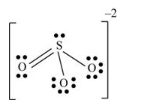
(f)
Interpretation:
The hybrid orbitals should be predicted which is used by sulfur atom(s) in
Concept Introduction:
When two atomic orbitals combine with each other to produce hybrid orbitals, redistribution of energy of orbitals of distinct atoms to form orbitals with equal energy occurs. This process is known as hybridization and the formed new orbitals are known as hybrid orbitals.
When the atomic orbitals overlap with each other in a region of high electron density, then molecular orbitals are formed. Overlapping of atomic orbitals determines the efficiency of interaction between atomic orbitals. Energy of bond molecular orbitals is less than the nonbonding molecular orbitals.
(f)
Explanation of Solution
On the basis of types of orbitals involved in mixing, different hybridization is classified as sp, sp2, sp3, sp3d, sp3d2, sp3d3.
sp-hybridization: It is formed when one s and one p orbital mix with each other in same shell of an tom to produce two new equal orbitals. This hybridization takes place in linear molecules.
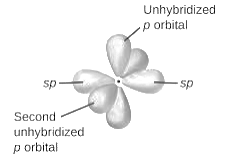
sp2-hybridization: It is formed when one s and two p orbital mix with each other in same shell of an tom to produce three new equal orbitals. This hybridization takes place in molecules exhibits trigonal planar geometry.

sp3-hybridization: It is formed when one s and three p orbital mix with each other in same shell of an tom to produce four new equal orbitals. This hybridization takes place in molecules exhibits tetrahedral geometry. In this hybridization, no p-unhybridized orbital is present as all are hybridized and form four sigma bonds.
The given molecule is
Number of valence electrons in sulfur = 6
Number of valence electrons in oxygen = 6
There are four oxygen atoms and one sulfur atom present in the molecule and charge on the molecule is equal to -2.
Total number of valence electrons =
Here, sulfur atom is linked with four oxygen atoms where two oxygen atoms are single bonded with sulfur and two oxygen atoms are double bonded with sulfur. By bonding in this way, each atom completes its octet.
Thus, geometry of
Electronic configuration of sulfur is
Electronic configuration of oxygen is
Sulfur atom uses one s-orbital and three p orbitals and thus hybridization of sulfur atom is sp3
Lewis structure of

(g)
Interpretation:
The hybrid orbitals should be predicted which is used by sulfur atom(s) in
Concept Introduction:
When two atomic orbitals combine with each other to produce hybrid orbitals, redistribution of energy of orbitals of distinct atoms to form orbitals with equal energy occurs. This process is known as hybridization and the formed new orbitals are known as hybrid orbitals.
When the atomic orbitals overlap with each other in a region of high electron density, then molecular orbitals are formed. Overlapping of atomic orbitals determines the efficiency of interaction between atomic orbitals. Energy of bond molecular orbitals is less than the nonbonding molecular orbitals.
(g)
Explanation of Solution
On the basis of types of orbitals involved in mixing, different hybridization is classified as sp, sp2, sp3, sp3d, sp3d2, sp3d3.
sp-hybridization: It is formed when one s and one p orbital mix with each other in same shell of an tom to produce two new equal orbitals. This hybridization takes place in linear molecules.
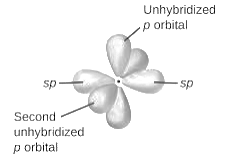
sp2-hybridization: It is formed when one s and two p orbital mix with each other in same shell of an tom to produce three new equal orbitals. This hybridization takes place in molecules exhibits trigonal planar geometry.

sp3-hybridization: It is formed when one s and three p orbital mix with each other in same shell of an tom to produce four new equal orbitals. This hybridization takes place in molecules exhibits tetrahedral geometry. In this hybridization, no p-unhybridized orbital is present as all are hybridized and form four sigma bonds.
The given molecule is
Number of valence electrons in sulfur = 6
Number of valence electrons in fluorine = 7
There are twofluorine atoms and one sulfur atom present in the molecule and charge on the molecule is equal to 0.
Total number of valence electrons =
Here, sulfur atom is linked with two fluorine atoms by sigma bond. By bonding in this way, each atom completes its octet.
Thus, geometry of
Electronic configuration of sulfur is
Electronic configuration of fluorine is
Sulfur atom uses one s-orbital and three p orbitals and thus hybridization of sulfur atom is sp3 implies hybrid orbitals are present.
Lewis structure of

(h)
Interpretation:
The hybrid orbitals should be predicted which is used by sulfur atom(s) in
Concept Introduction:
When two atomic orbitals combine with each other to produce hybrid orbitals, redistribution of energy of orbitals of distinct atoms to form orbitals with equal energy occurs. This process is known as hybridization and the formed new orbitals are known as hybrid orbitals.
When the atomic orbitals overlap with each other in a region of high electron density, then molecular orbitals are formed. Overlapping of atomic orbitals determines the efficiency of interaction between atomic orbitals. Energy of bond molecular orbitals is less than the nonbonding molecular orbitals.
(h)
Explanation of Solution
On the basis of types of orbitals involved in mixing, different hybridization is classified as sp, sp2, sp3, sp3d, sp3d2, sp3d3.
sp-hybridization: It is formed when one s and one p orbital mix with each other in same shell of an tom to produce two new equal orbitals. This hybridization takes place in linear molecules.
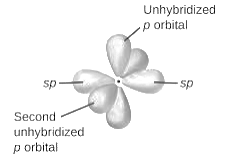
sp2-hybridization: It is formed when one s and two p orbital mix with each other in same shell of an tom to produce three new equal orbitals. This hybridization takes place in molecules exhibits trigonal planar geometry.
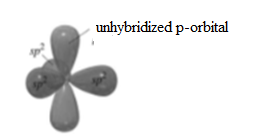
sp3-hybridization: It is formed when one s and three p orbital mix with each other in same shell of an tom to produce four new equal orbitals. This hybridization takes place in molecules exhibits tetrahedral geometry. In this hybridization, no p-unhybridized orbital is present as all are hybridized and form four sigma bonds.
The given molecule is
Number of valence electrons in sulfur = 6
Number of valence electrons in fluorine = 7
There are four fluorine atoms and one sulfur atom present in the molecule and charge on the molecule is equal to 0.
Total number of valence electrons =
Here, sulfur atom is linked with four fluorine atoms by sigma bond. By bonding in this way, each atom completes its octet. Also, one lone pair of electrons is present on sulfur atom.
Thus, geometry of
Lewis structure of

(i)
Interpretation:
The hybrid orbitals should be predicted which is used by sulfur atom(s) in
Concept Introduction:
When two atomic orbitals combine with each other to produce hybrid orbitals, redistribution of energy of orbitals of distinct atoms to form orbitals with equal energy occurs. This process is known as hybridization and the formed new orbitals are known as hybrid orbitals.
When the atomic orbitals overlap with each other in a region of high electron density, then molecular orbitals are formed. Overlapping of atomic orbitals determines the efficiency of interaction between atomic orbitals. Energy of bond molecular orbitals is less than the nonbonding molecular orbitals.
(i)
Explanation of Solution
On the basis of types of orbitals involved in mixing, different hybridization is classified as sp, sp2, sp3, sp3d, sp3d2, sp3d3.
sp-hybridization: It is formed when one s and one p orbital mix with each other in same shell of an tom to produce two new equal orbitals. This hybridization takes place in linear molecules.

sp2-hybridization: It is formed when one s and two p orbital mix with each other in same shell of an tom to produce three new equal orbitals. This hybridization takes place in molecules exhibits trigonal planar geometry.
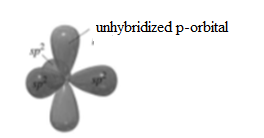
sp3-hybridization: It is formed when one s and three p orbital mix with each other in same shell of an tom to produce four new equal orbitals. This hybridization takes place in molecules exhibits tetrahedral geometry. In this hybridization, no p-unhybridized orbital is present as all are hybridized and form four sigma bonds.
The given molecule is
Number of valence electrons in sulfur = 6
Number of valence electrons in fluorine = 7
There are six fluorine atoms and one sulfur atom present in the molecule and charge on the molecule is equal to 0.
Total number of valence electrons =
Here, sulfur atom is linked with six fluorine atoms by sigma bond. By bonding in this way, each atom completes its octet. No lone pair of electrons is present on sulfur atom.
Thus, geometry of
Lewis structure of
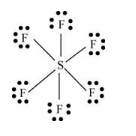
(j)
Interpretation:
The hybrid orbitals should be predicted which is used by sulfur atom(s) in
Concept Introduction:
When two atomic orbitals combine with each other to produce hybrid orbitals, redistribution of energy of orbitals of distinct atoms to form orbitals with equal energy occurs. This process is known as hybridization and the formed new orbitals are known as hybrid orbitals.
When the atomic orbitals overlap with each other in a region of high electron density, then molecular orbitals are formed. Overlapping of atomic orbitals determines the efficiency of interaction between atomic orbitals. Energy of bond molecular orbitals is less than the nonbonding molecular orbitals.
(j)
Explanation of Solution
On the basis of types of orbitals involved in mixing, different hybridization is classified as sp, sp2, sp3, sp3d, sp3d2, sp3d3.
sp-hybridization: It is formed when one s and one p orbital mix with each other in same shell of an tom to produce two new equal orbitals. This hybridization takes place in linear molecules.
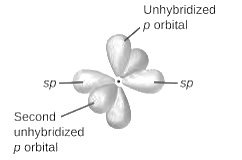
sp2-hybridization: It is formed when one s and two p orbital mix with each other in same shell of an tom to produce three new equal orbitals. This hybridization takes place in molecules exhibits trigonal planar geometry.
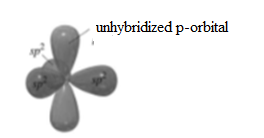
sp3-hybridization: It is formed when one s and three p orbital mix with each other in same shell of an tom to produce four new equal orbitals. This hybridization takes place in molecules exhibits tetrahedral geometry. In this hybridization, no p-unhybridized orbital is present as all are hybridized and form four sigma bonds.
The given molecule is
Number of valence electrons in sulfur = 6
Number of valence electrons in fluorine = 7
There are four fluorine atoms and two sulfur atoms present in the molecule and charge on the molecule is equal to 0.
Total number of valence electrons =
Here, two sulfur atoms are linked by sigma bond. The three fluorine atoms are linked by one sulfur atom and one fluorine atom is linked with another sulfur atom. By bonding in this way, each atom completes its octet. Also, one lone pair of electrons is present on one sulfur atom and two lone pairs of electrons are present on another sulfur atom.
Thus, geometry of
Lewis structure of
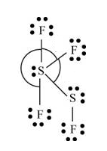
Want to see more full solutions like this?
Chapter 14 Solutions
CHEM.PRINC.W/OWL2+REBATE+2 SUPPL.>IP<
- Specify the electron-pair and molecular geometry for each underlined atom in the following list. Describe the hybrid orbital set used by this atom in each molecule or ion. (a) BBr3 (b) CO2 (c) CH2Cl2 (d) CO32arrow_forwardIn each of the following polyatomic ions, the central atom has an expanded octet. Determine the number of electron pairs around the central atom and the hybridization in (a) SF22- (b) AsCl6- (c) SCl42-arrow_forwardSpecify the electron-pair and molecular geometry for each underlined atom in the following list. Describe the hybrid orbital set used by this atom in each molecule or ion. (a) CSe2 (b) SO2 (c) CH2O (d) NH4ssarrow_forward
- Which of the following species has trigonal-pyramidal geometry? (a) PCl3 (b) BCl3 (c) SO3 (d) ClF3arrow_forwardUse Lewis structures and VSEPR theory to predict the electron-region and molecular geometries of (a) PSCl3. (b) SOF6. (c) [S2O4]2. (d) [TeF4]2. Note any differences between these geometries.arrow_forwardGive the hybridization of each central atom in the following molecules. (a) cyclohexene (b) phosgene, Cl2CO (c) glycine, H2NC(1)H2C(2)OOH (Note: Numbers in parentheses label each carbon atom.)arrow_forward
- The hybridization of the two carbon atoms differs in an acetic acid, CH3COOH, molecule. (a) Designate the correct hybridization for each carbon atom in this molecule. (b) What is the approximate bond angle around each carbon?arrow_forwardPredict the valence electron molecular orbital configurations for the following, and state whether they will be stable or unstable ions. (a) Na,2+ (b) Mg,2 (c) AI,2 (d) Si,2 (e) p2+ (f) s,2 (g) F,2 (h) Ar,2 40. Predict the valence electron molecular orbital configurations for the following, and state whether they will be stable or unstable ions. (a) Na22+ (b) Mg22+ (c) Al22+ (d) Si22+ (e) P22+ (f) S22+ (g) F22+ (h) Ar22+arrow_forward
 Chemistry: Principles and PracticeChemistryISBN:9780534420123Author:Daniel L. Reger, Scott R. Goode, David W. Ball, Edward MercerPublisher:Cengage Learning
Chemistry: Principles and PracticeChemistryISBN:9780534420123Author:Daniel L. Reger, Scott R. Goode, David W. Ball, Edward MercerPublisher:Cengage Learning Chemistry by OpenStax (2015-05-04)ChemistryISBN:9781938168390Author:Klaus Theopold, Richard H Langley, Paul Flowers, William R. Robinson, Mark BlaserPublisher:OpenStax
Chemistry by OpenStax (2015-05-04)ChemistryISBN:9781938168390Author:Klaus Theopold, Richard H Langley, Paul Flowers, William R. Robinson, Mark BlaserPublisher:OpenStax Chemistry: The Molecular ScienceChemistryISBN:9781285199047Author:John W. Moore, Conrad L. StanitskiPublisher:Cengage Learning
Chemistry: The Molecular ScienceChemistryISBN:9781285199047Author:John W. Moore, Conrad L. StanitskiPublisher:Cengage Learning Chemistry & Chemical ReactivityChemistryISBN:9781337399074Author:John C. Kotz, Paul M. Treichel, John Townsend, David TreichelPublisher:Cengage Learning
Chemistry & Chemical ReactivityChemistryISBN:9781337399074Author:John C. Kotz, Paul M. Treichel, John Townsend, David TreichelPublisher:Cengage Learning Chemistry & Chemical ReactivityChemistryISBN:9781133949640Author:John C. Kotz, Paul M. Treichel, John Townsend, David TreichelPublisher:Cengage Learning
Chemistry & Chemical ReactivityChemistryISBN:9781133949640Author:John C. Kotz, Paul M. Treichel, John Townsend, David TreichelPublisher:Cengage Learning General Chemistry - Standalone book (MindTap Cour...ChemistryISBN:9781305580343Author:Steven D. Gammon, Ebbing, Darrell Ebbing, Steven D., Darrell; Gammon, Darrell Ebbing; Steven D. Gammon, Darrell D.; Gammon, Ebbing; Steven D. Gammon; DarrellPublisher:Cengage Learning
General Chemistry - Standalone book (MindTap Cour...ChemistryISBN:9781305580343Author:Steven D. Gammon, Ebbing, Darrell Ebbing, Steven D., Darrell; Gammon, Darrell Ebbing; Steven D. Gammon, Darrell D.; Gammon, Ebbing; Steven D. Gammon; DarrellPublisher:Cengage Learning





